A-Classes
Ike Jackets
Although the 4-Pocket Tunic was worn by many of the members of 101st Airborne, these were all replaced in early 1945 by the Ike Jacket. This circumvented the need to have two types of jackets; officers and enlisted men now shared the same jacket. It was simpler, cheaper and required less cloth to make. Despite the almost identical look of each Ike Jacket, despite being made by different manufacturers, after the application of each soldier's medals, awards, overseas stripes, hash marks, rank and unit patches, almost no two jackets looked the same. Even if all these accoutrements happened to match, some soldiers also added DI's (Divisional Insignia), cords issued by foreign countries (optional) and only two were supposed to be worn (although in some cases they were issued three... some choose two, others ignored the rules and wore all three! So, expect to see significant variations across jackets.
Enlisted men should choose the 4-Pocket Tunic over the Ike Jacket. The 4-pocket could have been worn over the course of the entire war, with the Ike Jacket only being issued late war. Awards should be kept to a bare minimum when doing Normandy. In fact, the average enlisted man would only have his marksman qualifications and parachute wings at this point. No WW2 medal ribbons could have been earned yet.
If you look at lots of troopers in A-Class uniforms, of almost all the ones wearing 4-Pocket Tunics, particularly those who were killed in 1944, have the bare minimum of insignia. Their jackets can look very bare!
The PFC on the right wears the 4-pocket tunic. He has the early style parachute patch on his garrison cap. His jacket is as simple as any 101st Paratrooper can be. He has his Paratroopers Wings and the 101st Infantry Division Patch. For a trooper to have had much more than this on a 4-pocket would likely be incorrect for an enlisted man. Another interesting point is that it doesn't look like he's wearing the Presidential Unit Citation (PUC), so this would probably indicate a pre-June 1944 photo.


Left, another enlisted-mans uniform; this time the Ike Jacket. Lets start looking at placement of the Parachute Wings and the Combat Infantry Badge (CIB). This is the most common layout. The Parachute Wings are placed above the medal ribbon that sits on the top of the pocket seam. The CIB is placed on the center of the pocket flap and then any marksman awards on the center of the pocket itself.
This is a great textbook example of a late-war Ike Jacket.
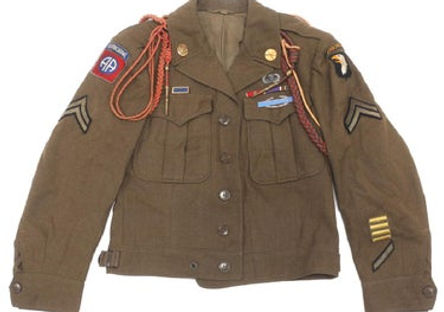
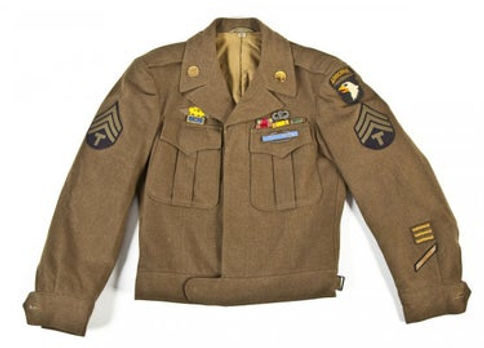
The two Ike Jackets above each have the same style layout as our textbook example. Note the one on the left has a rather sloppy Victory Medal ribbon, placed not only completely out of sequence, but also attached rather carelessly and too close to the Parachute Wings. Also note that the 'ruptured duck' award for honorable discharge is sewn just above the PUC as regulations stipulate. Overall, this example has rather a messy look to it.
The one on the right has some interesting and noteworthy features. This one has all three of the foreign shoulder cords: Orange for Netherlands, Bright Red for France, Reg/Green for Belgium. Now as stated before, regulations require that only two be worn, one on each arm. However, this example probably was assembled at the time the cords were issued; they came with no instructions on how or where to wear them. The French Cord has been attached in front of the arm without placing the sleeve through the loop. Of course, the sleeve could have been pulled out through the cord, but why?
Previous unit insignia can be a very interesting feature that can lead to a totally unique jacket. Most commonly a soldier would come from a similar unit, like the corporal's jacket above. He came from the 82nd and went into the 101st. However, with regard to your own jacket, you could either have the patch of a previous reenacting unit in which you were a participant (for example 29th Inf Div) or use a unit that would be commonly paired with your current unit (like the 82nd Abn), or simply use a unit in which you have a particular interest (i.e. the 1st Armored Div).


Above left - Another common and good-looking patch to use as the previous unit is the 1st Allied Airborne patch. The Parachute Wings are off center on this jacket which is a little weird. Another thing to note is the strange way the Netherlands shoulder cord is attached to the pocket. Oddly it is done the same way on the jacket on the right.
Above right - Again another nice patch to wear could be the red Airborne patch. As well as having the Netherlands cord worn in an unusual way, the cords for France are worn over the sleeve. Although a bit of a mess, an important thing to note here is that this is an officers Ike Jacket! Even the officers had no idea what they were supposed to do with these cords. As the Parachute Wings are not on this jacket, the CIB has correctly been placed above the medal bars.

Despite being a weird layout with the Parachute Wings on the pocket flap and the CIB over the medal bars, this jacket carries some really odd patches. The current unit is 17th Infantry with Airborne tab; the previous unit was the 17th Infantry with no Airborne tab? Was it a separate tab that was lost? Did he just not want to add it to the jacket for some reason? Given this example, possibly wearing another 101st patch on the right shoulder could also be an option!

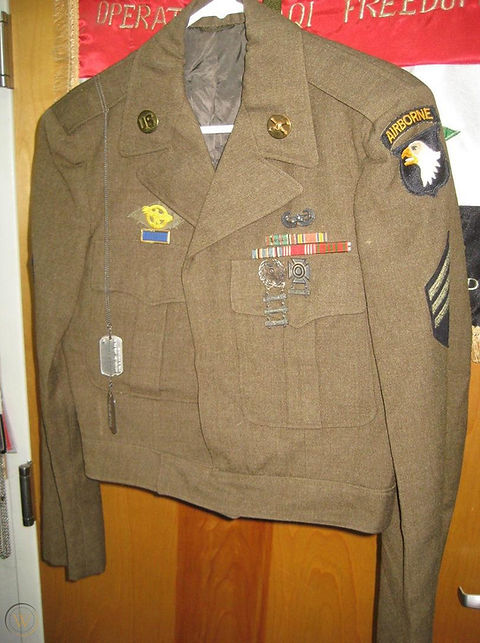
The two jackets above were worn by 101st Glider Troops (death crates!) as indicated by the Glider Badge in place of the Parachute Wings.
For the jacket on the left, the last ribbon on the right of the lower medal bar looks like the French Croix-de-Guerre. On the pocket is an interesting feature: two marksmanship awards. The award on the left is Expert (highest award) Level with 3 Weapon Qualification Clasps and the one on the right is Sharpshooter (middle award) Level with one Weapon Qualification Clasp, proving again that you can have more than one marksman award. Expect everyone to tell you, "Nobody ever did that...." The collar dog has the crossed cannons, signifying that this Technician Fourth Grade (T4) was in the Glider-Borne Field Artillery.
The Staff Sergeant (S/SGT) jacket on the right also has four Overseas Service Bars that indicate the recipient has served two years (each bar representing six months) overseas in a theater of war.
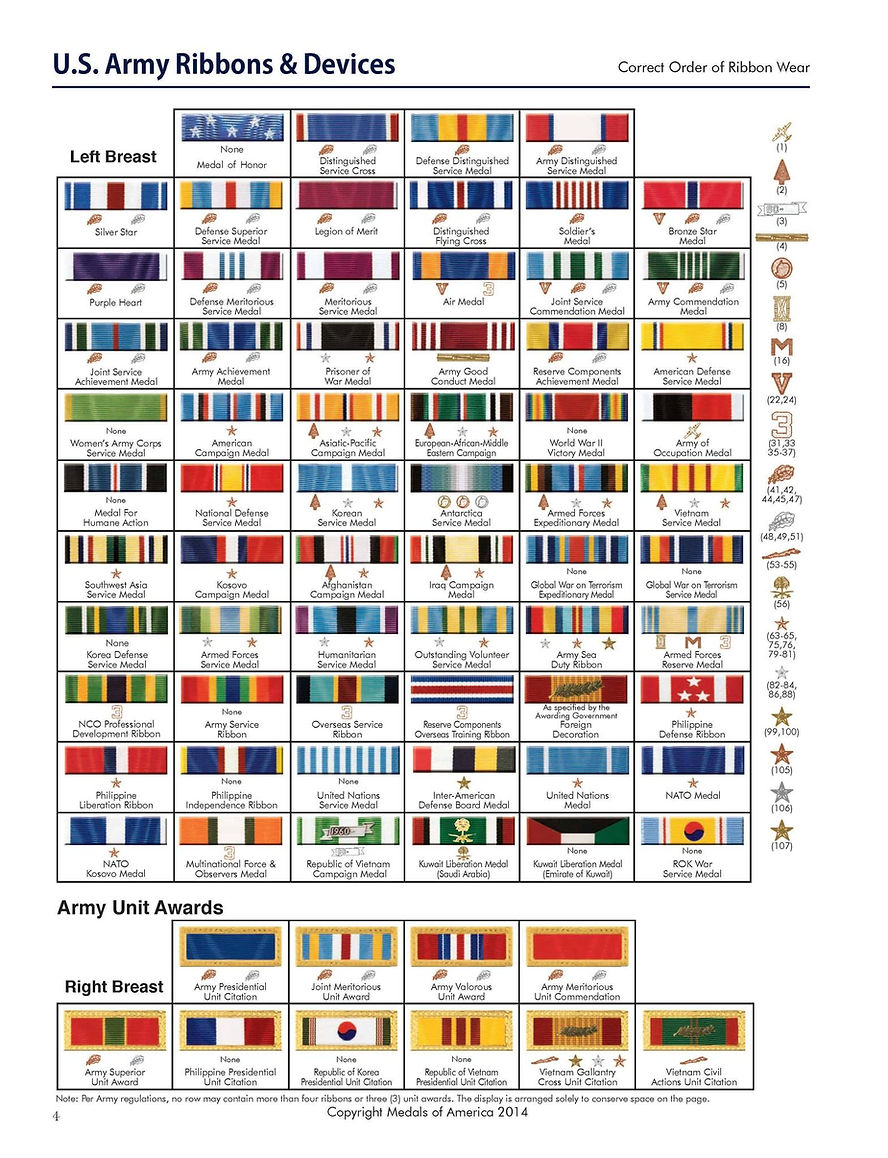


Divisional Insignia (DIs) - the two enlisted soldier's jackets above both include DIs. The soldier on the left has added two DI's that match his 82nd Inf Div shoulder patch. Jacket on the right has a 1st Allied Airborne DI on the right lapel and a 101st Inf Div on the left lapel, each matching the patch on the corresponding shoulder. Note that this jacket includes both a single Service Stripe, or "hash mark", (awarded for every 3 years of service) along with three Overseas Service Bars that indicate the recipient has served a year and a half (each bar representing six months) overseas in a theater of war. Another interesting note is the green stripe under the rank which indicates that this Sgt was a combat leader - another potential interesting touch to make your jacket more individual.
This fantastic First Sergeant (1st Sgt) Ike Jacket on the right is pretty much perfect. The foreign cords are worn correctly and there are only two. The medal bars are neat and level and in order. The Parachute Wings and CIB are bang-on center as well. This Top Kick certainly went through the ringer and back, being awarded both the Silver Star and the Bronze Star, along with two Purple Hearts. The ETO Medal shows 3 campaign stars and an invasion arrowhead!
On top of all this bling, he has added two 506th PIR DI's and is wearing them under the collar dogs.
Also, note the unusual dark blue colour early paratroopers garrison cap patch.
However for us, the most amazing thing to see here is the seldom seen Pathfinder patch, neatly trimmed out and sewn above the Service Stripe and four Overseas Service Bars.
Purchasing
Buying an A-Class involves finding lots of pieces from lots of different locations. You can find a few companies like Soldier of Fortune who offer A-Class packages with everything included but... the jackets are pretty ugly and are not great quality. The insignia and patches are all reproduction and, again, poor quality (which is a shame as originals of some of the patches are the same sort of prices as the crappy-looking reproductions.
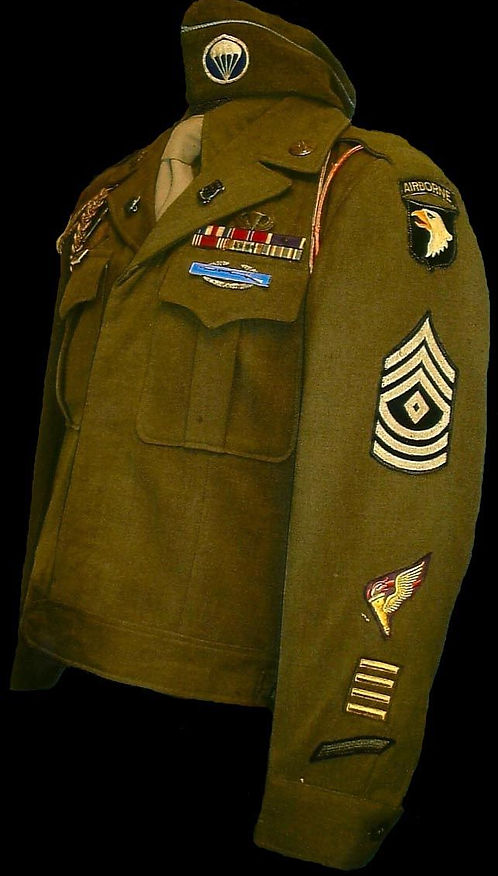
Now for those ladies who want a challenge in re-enacting, there is a way to wear those pretty jump wings on your A-Class. However, be expected to be told its wrong by so many people - fellow re-enactors as well as the public.
This wartime photograph from 1944 is of Woman's Army Corps (WAC) Rigger Marie Margaret McMillin. There is a mountain of information on her from before the war as her history is very interesting. She was already an expert in civilian parachuting before the war and so this was a natural calling for her.
There is a whole page of information on this subject written by Poppy Mercer who has become extremely knowledgeable in this area. She has kindly agreed to include a link to her research. She took up this as one of her impressions for re-enacting and, as you can imagine, gets plenty of comments about those "jump wings".
Click the photo left or the button below, to learn more.
Collar Dogs
These are a simply one: buy original. These can be obtained from almost every militaria fair in the world. One 'U.S.' and one 'Crossed Rifles'. Remember to get the disc types if you are an enlisted; cut-out type if you're an officer.
DI's
Sadly, almost no original DI's of Paratrooper Units come up for sale and, if they do, you will rarely find a matching pair and that's not even considering the cost! Reproductions of these are the only practical option if you want them. It's easy to find 502nd or 101st DIs. Enlisted men wear these on the lapels with the collar dogs above the lapel notch and the DIs below the lapel notch, officers on the shoulders between the epaulette button and the rank insignia.
Rank
The enlisted rank insignia on the A-Class should always be the green chevrons, either wool or sewn in green thread. Originals of these are easy to find, again at any militaria show or online. Avoid the reproductions as most are fairly crappy.
Shoulder Patches
I have covered 101st patches in some detail on the 'patches' page. You can pretty well forget the idea of an original 101st patch these days. The price is usually ridiculous and there are far too many near identical fakes out there that will easily fool even experienced collectors. A reproduction 101st patch is the only sensible option. However, for your 'previous unit' patch an original might be an achievable option, depending on which unit you opt for. Lots of original World War 2 U.S. Infantry Division patches are out there at reasonable prices.
Medal Ribbons
There aren't really reproductions of these, as they are modern-made ribbons. These can be obtained easily for not much money. Originals are also fairly easy to obtain; lots of these can be faded and frayed, but some are in fantastic condition and usually don't go for a lot.
As a group, we have decided that no gallantry medals will ever be worn; with the exception being that if you served in the military and were awarded a gallantry medal, then an American WW2 ribbon of similar award may be worn. No purple hearts, no campaign medals to be worn that couldn't have been awarded at the time period we are portraying. For example, if we're portraying Normandy then an ETO ribbon cannot be worn.
Parachute Wings

There are two types to consider, firstly the standard metal version. These can be worn over a cloth backing unit designation oval. There are lots of originals out there to purchase, these range in price depending on the maker and condition. Modern jump wings are significantly less expensive compared to the World War 2 originals, so these are a much more viable option.
There are complete cloth sewn versions, I recently saw a
lovely original 502nd cloth version for $109, shown here:
Combat Infantry Badge

Just like the Parachute Wings, the Combat Infantry Badge (CIB) is still around now and therefore there are plenty of more modern versions that are far cheaper than a World War 2 example. Even when they look old, these are usually examples from Korea or Vietnam. There are plenty of reproductions, too (although why, I'm not certain, as a more modern CIB can be purchased for the same money as a reproduction). Almost all A-Class jackets belonging to those owners saw any combat would have worn the CIB. However, when you see the jackets from pre-Normandy invasion, they would not have had chance to earn the CIB yet, so like most things, this shouldn't be on your jacket either!

